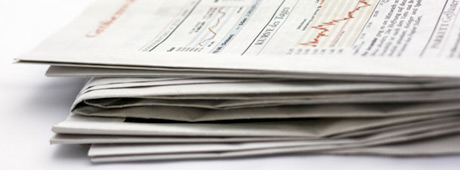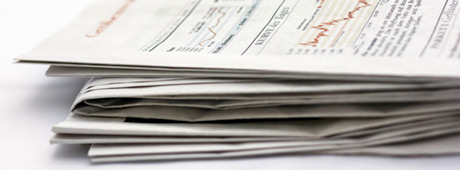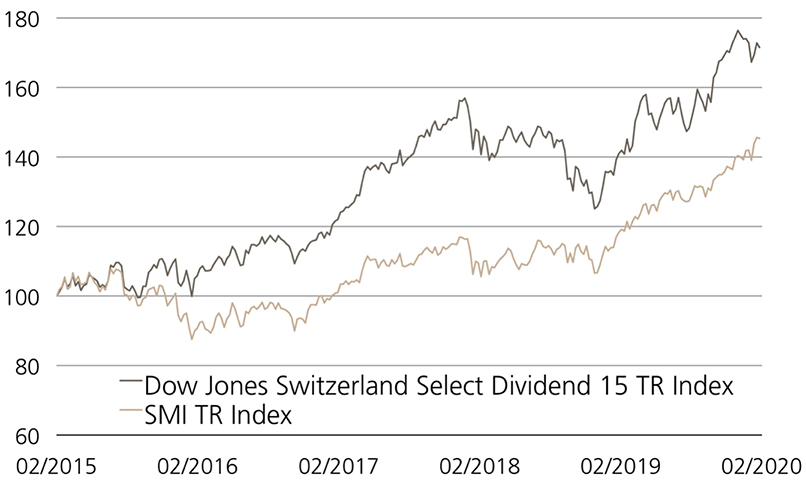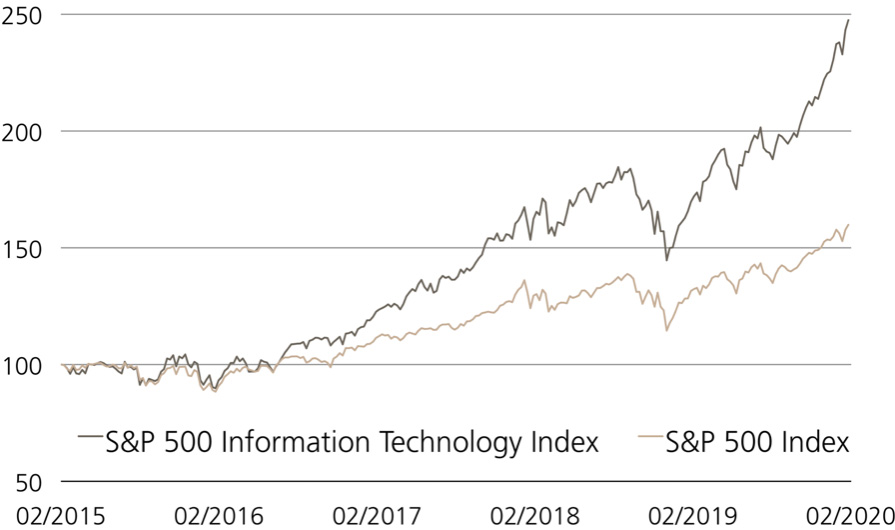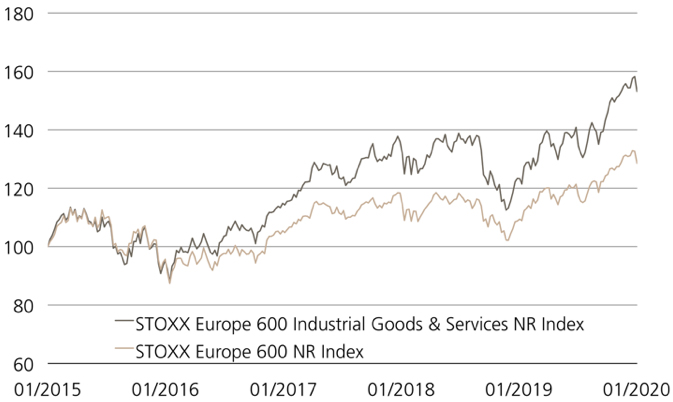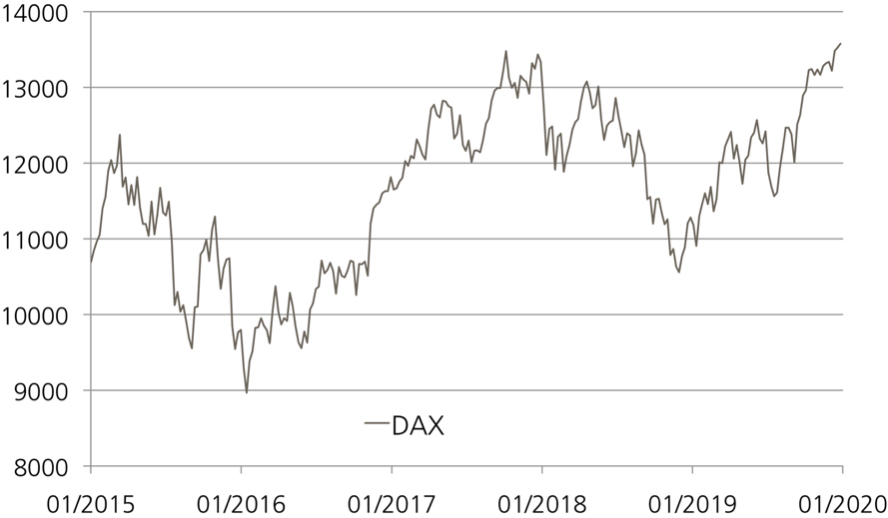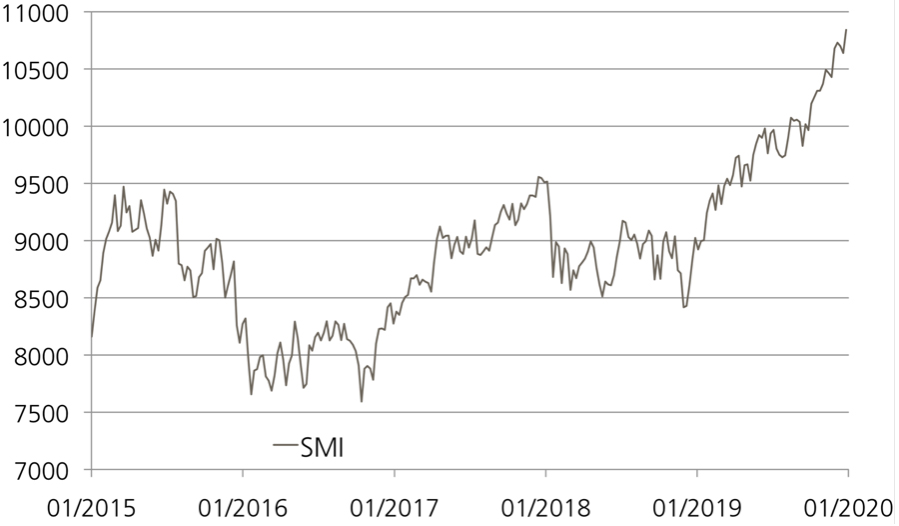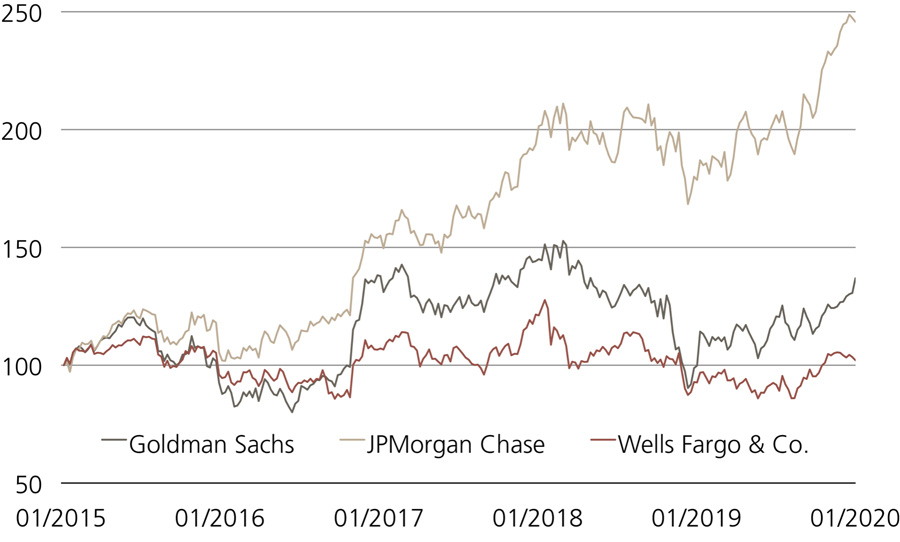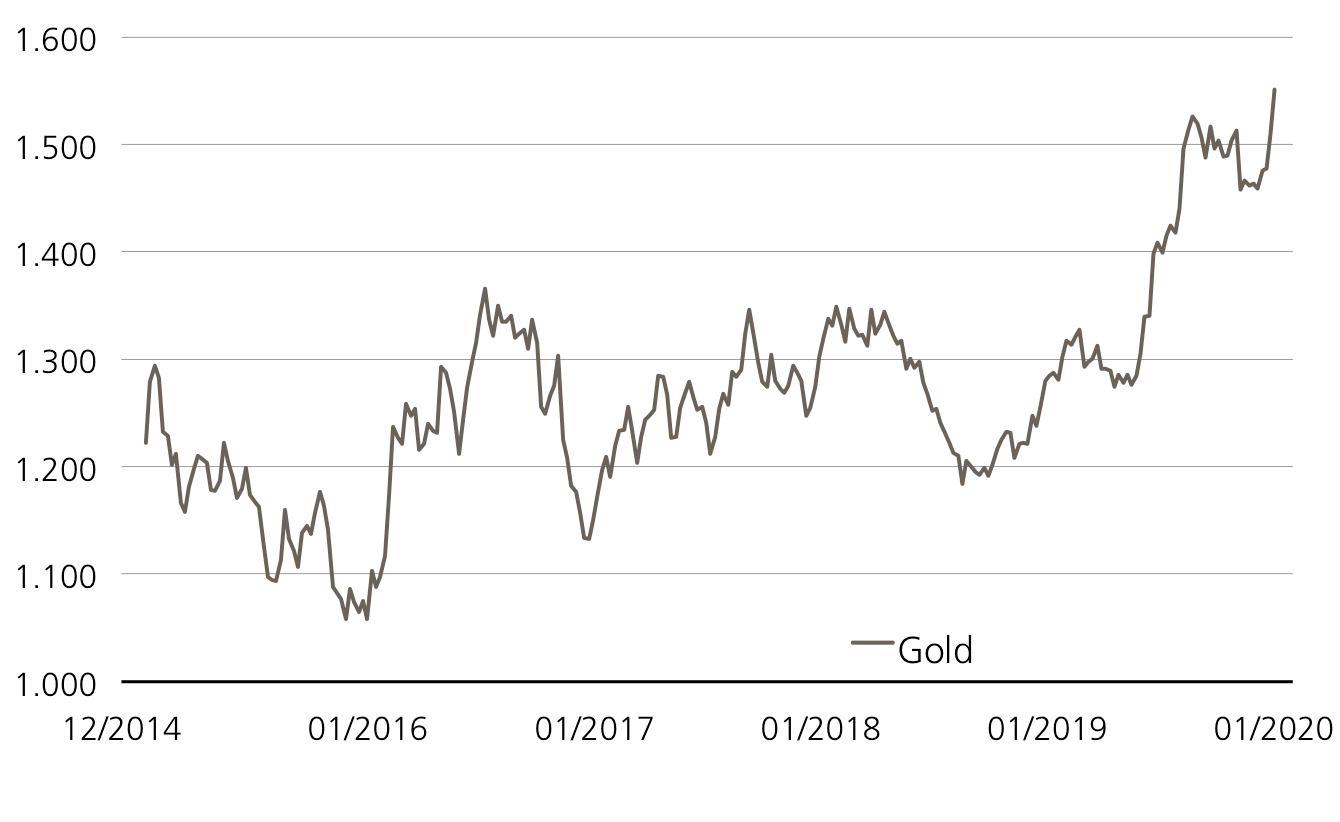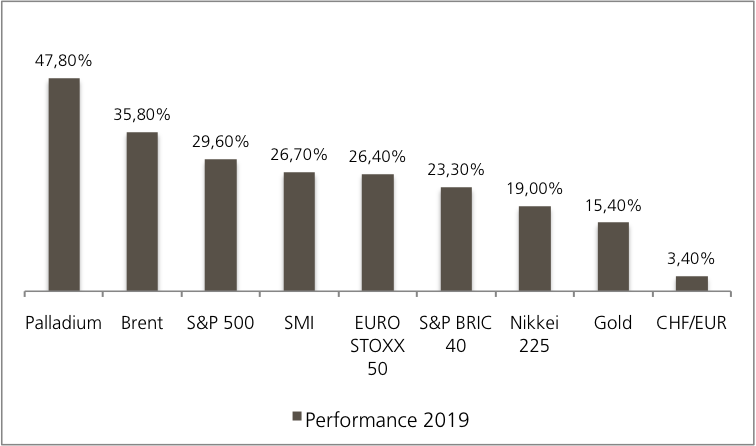Nichts für schwache Nerven
2. März 2020 – UBS Thema im Fokus
Nichts für schwache Nerven
Lange Zeit waren die Investoren an den Aktienmärkten nur noch Superlative gewohnt. Die Börsen stürmten von einem Hoch zum nächsten. Im März jährt sich der Auftakt der auf die Finanzkrise folgenden Hausse bereits das elfte Mal. Doch kurz vor dem Jubiläum setzte es einen kräftigen Dämpfer: Vergangene Woche brach der SMI um 11.5 Prozent ein – das grösste Minus seit dem Franken-Schock von Anfang 2015. Seit die Zahl der am Coronavirus erkrankten Menschen in Ländern ausserhalb Chinas deutlich zugenommen hat, geht an den Märkten die Angst vor der Rezession um. Zum Ausdruck kommt die erhöhte Nervosität auch an der impliziten Volatilität. Der aus den erwarteten Kursschwankungsbreiten für die 20 SMI™-Aktien errechnete VSMI™ hat sich Ende Februar weit mehr als verdoppelt (siehe Chart).
Zinssenkungen möglich
Gespannt warten Investoren nun darauf, ob und gegebenenfalls wie die Notenbanken auf den drohenden Abschwung reagieren. Vor dem Wochenende meldeten sich hochrangige Währungshüter zu Wort. SNB-Vizepräsident Fritz Zurbrügg skizzierte in einem Interview mit der „Finanz und Wirtschaft“ die mit dem Coronavirus einhergehenden Konjunkturrisiken für die Schweiz. Ausserdem strich er den Aufwertungsdruck bei dem als sicherer Hafen geltenden Schweizer Franken heraus. Gegenüber dem Euro ist die heimische Valuta Ende Februar auf den höchsten Stand seit Juli 2015 geklettert. Zurbrügg schloss vor dem skizzierten Hintergrund eine Zinssenkung nicht aus. (Quelle: Thomson Reuters, Medienbericht, 28.02.2020) Am 19. März gibt die SNB ihre geldpolitische Lagebeurteilung ab.
Einen Tag vorher trifft die US-Notenbank die nächste turnusgemässe Zinsentscheidung. Fed-Präsident Jerome Powell bezeichnete am Freitag die Fundamentaldaten der US-Wirtschaft als weiterhin stark. Allerdings machte er keinen Hehl aus den vom Virus ausgelösten Risiken. „Wir werden unsere Werkzeuge einsetzen und handeln, wie es angemessen ist, um die Wirtschaft zu unterstützen“, sagte Powell. (Quelle: Thomson Reuters, Medienbericht, 28.02.2020) Mittlerweile gehen die Märkte davon aus, dass es bereits im März in den USA zu einer deutlichen Zinssenkung kommt. Laut dem FedWatch Tool der CME Group wird das Fed den Leitsatz um 50 Basispunkte auf die neue Spanne von 1.00 Prozent bis 1.25 Prozent zurückschrauben. Während die Wahrscheinlichkeit hierfür vor einer Woche noch bei null lag, ist sie per 28. Februar auf 94.9 Prozent hochgeschnellt.
Jede Menge politische Brisanz
Ihren aktuellen Konjunkturbericht „Beige Book“ veröffentlicht das Fed bereits am kommenden Mittwoch. Weitere Indizien für die Verfassung der weltgrössten Volkswirtschaft wird der Arbeitsmarktbericht am Freitag liefern. Laut einer Auswertung der Nachrichtenagentur Reuters gehen Ökonomen im Schnitt davon aus, dass in den Staaten ausserhalb der Landwirtschaft im Februar 178.000 neue Stellen entstanden sind. Für den Januar hatte das Arbeitsministerium 225.000 zusätzliche Jobs gemeldet.
Bereits am Dienstag rückt der US-Präsidentschaftswahlkampf in den Fokus. Die Demokraten richten in 14 Bundesstaaten ihre Vorwahlen aus, darunter die bevölkerungsreichen Staaten Kalifornien und Texas. Beim „Super Tuesday“ steht die Frage im Mittelpunkt, ob der linksgerichtete Bernie Sanders die Führung im Rennen um die Kandidatur verteidigen kann. Am Samstag feierte der zuvor schwach abschneidende Joe Biden einen ersten Erfolg. Bei den Vorwahlen der Demokraten in South Carolina setzte sich der frühere Vize-Präsident durch. Mit New Yorks ehemaligem Bürgermeister Michael Bloomberg wird ein prominenter Kandidat am Dienstag erstmals auf den Wahlzetteln stehen. (Quelle: Thomson Reuters, Medienbericht, 01.03.2020)
Zurück auf das Tableau kommt ab heute das Thema Brexit. In Brüssel beginnen die Verhandlungen zwischen der EU und Grossbritannien um die zukünftigen Handelsbeziehungen. London hatte zuletzt eine harte Gangart angekündigt. In Wien kommen am Mittwoch und Donnerstag die Vertreter der OPEC zusammen. Dabei dürfte vor allem die Frage im Raum stehen, ob die Organisation erdölexportierender Länder mit weiteren Förderkürzungen auf den starken Preisrückgang beim schwarzen Gold reagiert. Die Nordseegattung notiert auf dem tiefsten Niveau seit Ende 2018.
VSMI™ Index
(5 Jahre)¹
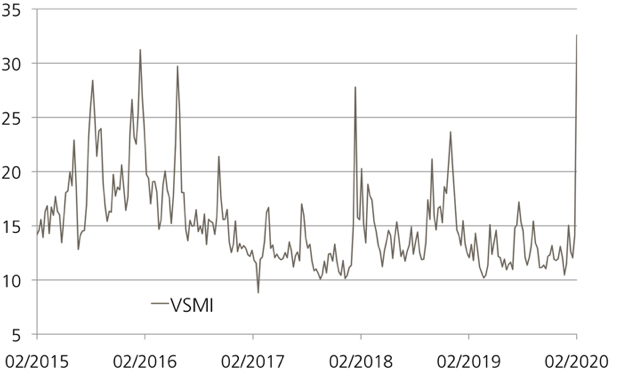
¹) Bitte beachten Sie, dass vergangene Wertentwicklungen keine Indikationen für künftige Wertentwicklungen sind.
Stand: 28.02.2020; Quelle: Bloomberg
Wichtige Wirtschafts- und Unternehmenstermine
| Datum | Uhrzeit | Land | Ereignis |
| 02.03.2020 | 16:00 | US | ISM Einkaufsmanagerindex Februar |
| 02.03.2020 | 16:00 | US | Bauausgaben Januar |
| 03.03.2020 | k.A. | CH | OC Oerlikon Jahreszahlen |
| 03.03.2020 | 07:00 | CH | Lindt & Sprüngli Jahreszahlen |
| 03.03.2020 | 07:45 | CH | BIP 4. Quartal 2019 |
| 03.03.2020 | 08:00 | DE | Beiersdorf Jahreszahlen |
| 03.03.2020 | 15:00 | CH | Logitech Analysten- und Investorentag |
| 04.03.2020 | 06:00 | CH | Bucher Industries Jahreszahlen |
| 04.03.2020 | 07:00 | CH | Helvetia Holding Jahreszahlen |
| 04.03.2020 | 08:00 | DE | Detailhandelsumsätze Januar |
| 04.03.2020 | 08:30 | CH | Konsumentenpreise Februar |
| 04.03.2020 | 09:55 | DE | Einkaufsmanagerindex Februar |
| 04.03.2020 | 10:00 | EZ | Einkaufsmanagerindex Februar |
| 04.03.2020 | 11:00 | EZ | Detailhandelsumsätze Januar |
| 04.03.2020 | 14:15 | US | ADP Arbeitsmarktbericht Februar |
| 04.03.2020 | 20:00 | US | Beige Book |
| 05.03.2020 | k.A. | AT | OPEC: 178. (ausserordentliches) Treffen |
| 05.03.2020 | 07:00 | DE | Merck KGaA Jahreszahlen |
| 05.03.2020 | 07:30 | DE | Henkel Jahreszahlen |
| 05.03.2020 | 08:30 | DE | Continental Jahreszahlen |
| 05.03.2020 | 08:30 | DE | Vonovia Jahreszahlen |
| 05.03.2020 | 16:00 | US | Auftragseingang Industrie Januar |
| 06.03.2020 | k.A. | AT | OPEC: Ministertreffen. |
| 06.03.2020 | 08:00 | DE | Industrieproduktion Januar |
| 06.03.2020 | 14:30 | US | Arbeitsmarktbericht Februar |
Stand: 02.03.2020; Quelle: Thomson Reuters
Weitere Blogeinträge:
Das nächste Staccato
Follow us on LinkedIn 18. März 2024 Das nächste Staccato Die Bank of Japan (BoJ) residiert in einem neobarocken Gebäude im Herzen von Tokio. Am morgigen Dienstag könnte dort [...]
Zinsdebatte und kein Ende
Follow us on LinkedIn 11. März 2024 Zinsdebatte und kein Ende Wohin man an den Märkten auch blickt, die Bullen scheinen das Sagen zu haben. Wall Street, Nikkei, Gold [...]
Währungshüter im Fokus
Follow us on LinkedIn 04. März 2024 Währungshüter im Fokus Die Teuerung in der Eurozone gibt weiter nach. Laut vorläufigen Berechnungen lagen die Konsumentenpreise im Februar 2024 um 2.6 [...]
